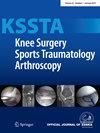Revision rates and progression to shoulder arthroplasty after arthroscopic repair of massive rotator cuff tears
Abstract
Purpose
The purpose of this systematic review was to assess the rate of progression to reverse total shoulder arthroplasty (RTSA) and to other interventions as revision surgeries after an arthroscopic repair of a massive rotator cuff tear (MRCT). Additionally, the review aimed at defining the best arthroscopic approach for the treatment of MRCTs in terms of failure and revision rates.
Methods
The purpose of this systematic review and meta-analysis was to evaluate the rates of progression to reverse total shoulder arthroplasty in patients who underwent primary arthroscopic repair of an MRCT with different arthroscopic procedures. A meta-analysis was performed to compare the rate of progression to revision surgery and reverse total shoulder arthroplasty.
Results
Eighteen articles were included in the qualitative synthesis and 14 articles were included in the meta-analysis. Overall, 934 patients and 950 shoulders were involved in the review. Seven-hundred and thirty patients and 735 shoulders were included in the meta-analysis. The proportion of revisions to reverse total shoulder arthroplasty was 0.9%, 3.3% and 0.1% for complete repair, partial repair and superior capsular reconstruction, respectively. No statistically significant differences were found across the groups in terms of progression to reverse total shoulder arthroplasty (n.s.). The average proportions of revisions to interventions different than reverse total shoulder arthroplasty. were 0.9% for complete repair, 2.0% for partial repair and 2.0% for superior capsular reconstruction again, no statistically relevant difference was found among the groups (n.s.).
Conclusions
The current review finds no statistically significant differences in the progression to reverse total shoulder arthroplasty or other revision procedures among partial repair, complete repair and superior capsular reconstruction for massive irreparable rotator cuff tears. It is crucial to understand the long-term outcomes of different surgical techniques for massive rotator cuff tears, particularly regarding failure rates and progression to further procedures.
Level of Evidence
Level IV.





 求助内容:
求助内容: 应助结果提醒方式:
应助结果提醒方式:


